You’re struggling to achieve visibility in search results despite creating quality content and following traditional SEO practices. Your website gets lost among millions of search results, and you’re wondering why your competitors consistently outrank you.
Traditional organic rankings are no longer enough. Today’s search engine results page has evolved into a complex ecosystem where serp features dominate prime real estate. Without understanding how to find serp features opportunities, you risk losing valuable traffic to competitors who have mastered these enhanced search results.
This comprehensive guide will show you exactly how to identify, target, and win valuable serp features that can dramatically boost your search visibility, drive more organic traffic, and establish your authority in your niche.
Key Takeaways
Strategic SERP Feature Mastery Framework:
- Enhanced Visibility Strategy – Modern search results contain numerous features that provide superior visibility compared to standard organic listings, creating competitive advantages for strategically positioned content.
- Performance-Driven Targeting – Focusing on specific serp features aligned with your content strengths delivers measurable improvements in visibility and click-through rates.
- Systematic Opportunity Analysis – Using proper tools and methodologies to discover serp feature opportunities ensures realistic success probabilities and optimal resource allocation.
- Continuous Optimization Approach – Monitoring serp feature presence and performance impact enables strategic refinement and maximized ROI.
The search landscape transformation demands understanding how search engines interpret user intent and deliver enhanced results through various serp features appearing alongside traditional search results.
What Are SERP Features?
SERP features represent the evolution of search engine results beyond traditional blue links. These enhanced elements appear throughout Google’s search results to provide users with more immediate, relevant, and interactive answers to their search queries.
When you perform a search today, you encounter a diverse array of serp features designed to satisfy different types of user intent. Featured snippets provide direct answers, knowledge panels offer comprehensive entity information, and local packs connect users with nearby businesses. Each feature serves a specific purpose in Google’s mission to organize the world’s information and make it universally accessible.
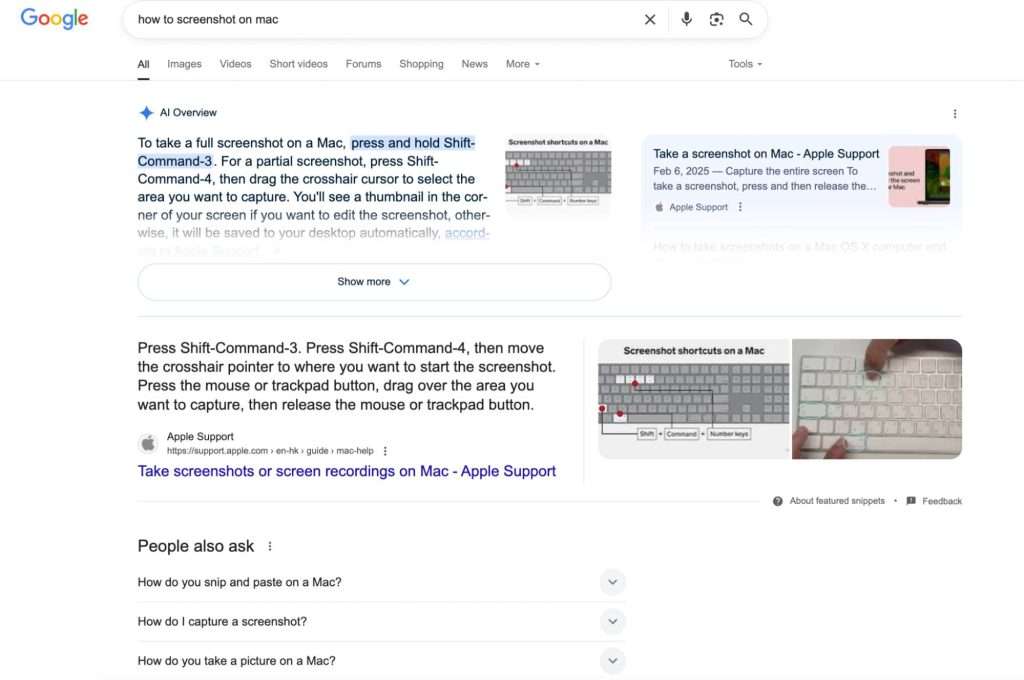
The concept of “position zero” emerged when featured snippets began appearing above traditional organic results. However, today’s search results page encompasses far more than just featured snippets. Google displays various serp features based on specific search queries, user location, device type, and search intent.
Understanding these features is crucial because they represent prime real estate on the search results page. Unlike traditional organic results that compete for ten blue links, serp features offer additional visibility opportunities that can help your content stand out, even if you’re not ranking number one for your target keywords.
Modern search engines understand that users seek different types of information. Some want quick answers, others need visual content, and many require local information. SERP features address these diverse needs while pr
Why SERP Features Matter for Your SEO Strategy
Your SEO strategy faces a critical evolution point. Traditional ranking optimization, while important, misses the expanded visibility opportunities that dominate modern search results. Competitors capturing serp features gain significant advantages through enhanced visibility and user engagement.
SERP features fundamentally alter user interaction patterns with search results. Users encounter rich, interactive elements providing immediate value rather than scanning traditional blue links. These features deliver superior brand awareness, authority establishment, and targeted organic traffic compared to standard listings.
The strategic importance extends beyond immediate visibility gains. SERP features represent search engine evolution toward sophisticated, user-centric experiences. Optimization alignment with these features positions your content for sustained success as search technology advances.
Impact on CTR and Visibility
Click-through rates vary significantly across serp features, but visibility benefits remain substantial. Featured snippets increase CTR by up to 30% for position zero pages, occurring because enhanced visibility establishes content authority and brand recognition.
Visual elements like image packs and video carousels generate higher engagement through immediate visual appeal. Local pack listings drive both online and offline conversions for location-based searches.
Visibility impact extends beyond immediate clicks. SERP features create brand recognition opportunities influencing future search behavior. Users encountering your content in featured snippets or knowledge panels demonstrate increased branded search activity and improved overall performance.
Influence on Rankings and Authority
SERP features create powerful indirect effects boosting website authority and search performance. Appearing in featured snippets, knowledge panels, or prominent features establishes content trustworthiness and niche authority.
User experience signals from SERP feature appearances contribute to improved website performance metrics. Higher click-through rates, extended session durations, and increased page views signal content relevance and value to search engines.
Authority benefits extend domain-wide. Consistent SERP feature appearances signal high-quality content production, improving related keyword rankings and accelerating new content ranking speed.
14 Essential SERP Features to Target
Modern search results contain numerous enhanced features, but focusing on the most impactful ones will maximize your optimization efforts. These 14 essential serp features represent the highest-value opportunities for most websites and content creators.
Each feature serves different user intents and appears for specific types of search queries. Understanding when and why these features trigger allows you to create targeted content that captures valuable search visibility. The following comprehensive analysis will help you identify which features align best with your content strategy and audience needs.
Comparison Table: Essential SERP Features
| Feature | Trigger Keywords | Difficulty | Traffic Potential | Optimization Priority |
| Featured Snippets | How, what, why, best | Medium | High | High |
| AI Overviews | Complex questions | High | Medium | Medium |
| People Also Ask | Question-based queries | Low | Medium | High |
| Knowledge Panels | Brand/entity names | High | Low | Low |
| Local Packs | Location + service | Medium | High | High |
| Sitelinks | Branded searches | Low | Medium | Medium |
| Image Packs | Visual content queries | Medium | Medium | Medium |
| Video Carousels | How-to, tutorials | Medium | High | High |
| Rich Snippets | Product, recipe, event | Low | Medium | High |
| Discussions | Problem-solving queries | Low | Low | Low |
| Popular Products | Shopping queries | High | High | Medium |
| Top Stories | News-related queries | High | Medium | Low |
Featured Snippets
Featured snippets represent the most coveted serp features, appearing at position zero above all traditional organic results. These concise answers extract relevant information from web pages to provide direct responses to user queries, making them incredibly valuable for establishing authority and driving traffic.
Google displays featured snippets in three primary formats: paragraph snippets for definitions and explanations, list snippets for step-by-step processes, and table snippets for comparative data. Each format serves different user intents and requires specific content optimization strategies.

The key to featured snippet optimization lies in understanding that Google seeks the most concise, accurate answer to user queries. Your content should provide clear, direct answers within the first 40-60 words, followed by supporting details that add context and depth.
Featured snippets typically appear for informational and commercial investigation queries. Terms like “how to,” “what is,” “best ways,” and “benefits of” frequently trigger snippet results. Research shows that pages ranking in the top 10 organic results have the highest probability of capturing featured snippets.
AI Overviews / AI-Powered Snapshots
AI Overviews represent Google’s newest approach to delivering comprehensive answers by synthesizing information from multiple sources. Unlike featured snippets that extract content from single pages, AI Overviews create original summaries that combine insights from various authoritative sources.
These AI-generated summaries appear at the top of search results for complex, multi-faceted queries where users need comprehensive information rather than simple answers. The feature includes supporting links to source websites, providing traffic opportunities for sites whose content contributes to the AI-generated response.
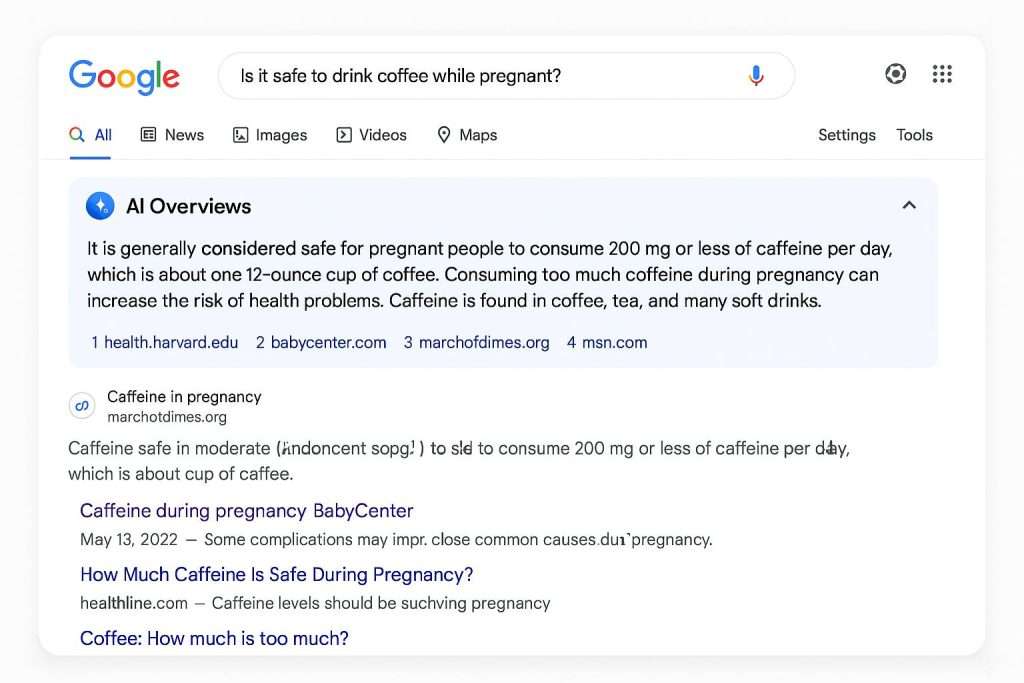
Optimizing for AI Overviews requires creating comprehensive, well-structured content that covers topics thoroughly while maintaining high accuracy and authority. Google’s AI systems prefer content that demonstrates expertise through detailed explanations, supporting evidence, and clear organization.
The challenge with AI Overviews lies in their unpredictable nature. While you can optimize content to increase inclusion probability, you cannot guarantee that your specific page will receive direct traffic since users may find answers within the AI-generated summary itself.
People Also Ask (PAA)
People Also Ask boxes create expanding opportunities for visibility through related question formats. These accordions appear throughout search results, typically between positions one and four, and dynamically generate additional questions based on user interaction patterns.
PAA boxes serve users who need clarification or have follow-up questions related to their initial search query. The feature helps search engines understand the broader context of user intent while providing content creators with opportunities to capture long-tail keyword traffic.

The dynamic nature of PAA boxes makes them particularly valuable for content strategy. When users click on questions within PAA boxes, Google generates additional related questions, creating an expanding web of content opportunities that can drive sustained traffic growth.
Successful PAA optimization requires understanding the question patterns that emerge around your target topics. Tools like AnswerThePublic and Google’s own autocomplete suggestions can help identify relevant questions, but analyzing existing PAA boxes provides the most accurate insights into user interests.
Knowledge Panels
Knowledge panels appear prominently on the right side of desktop search results (or at the top on mobile) when users search for specific entities like businesses, people, places, or organizations. These panels pull information from Google’s Knowledge Graph to provide comprehensive overviews of entity information.
Securing a knowledge panel provides exceptional brand visibility and establishes credibility through association with Google’s authoritative information sources. The panels include key details like business information, social media links, related entities, and frequently asked questions.

Knowledge panels represent long-term SEO investments rather than quick wins. Building the authority and recognition necessary for panel creation requires consistent brand building, comprehensive online presence, and authoritative content creation across multiple platforms.
The information displayed in knowledge panels comes from various sources including Wikipedia, official websites, social media profiles, and other authoritative platforms. Ensuring consistency across these sources while actively managing your entity’s online presence increases the likelihood of panel creation and accuracy.
Local Packs
Local pack listings appear for location-specific searches, displaying three businesses on a map with key information like addresses, phone numbers, reviews, and hours. These features are crucial for businesses serving local markets and represent high-conversion traffic opportunities.
Local pack optimization requires a comprehensive approach that includes Google Business Profile optimization, local keyword targeting, and consistent NAP (Name, Address, Phone) information across all online directories and listings.
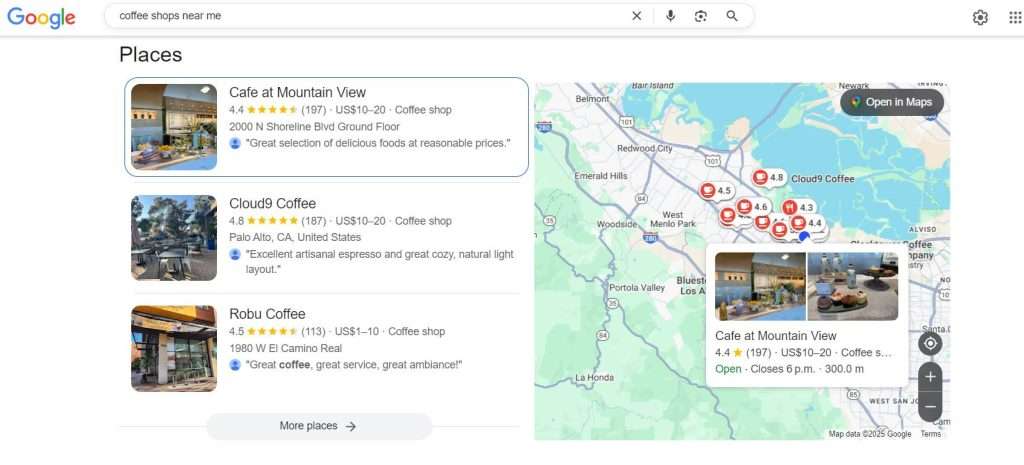
The local pack algorithm considers factors like proximity to the searcher, relevance to the search query, and business prominence. Reviews, ratings, and engagement with your Google Business Profile significantly influence local pack rankings.
Local keywords often trigger multiple serp features simultaneously, including local packs, knowledge panels for local businesses, and related local content. This creates opportunities for comprehensive local market domination when optimization strategies are properly coordinated.
Sitelinks
Sitelinks appear beneath main search results for branded queries, providing users with direct navigation to specific website sections. These enhanced listings take up additional search real estate while helping users find relevant content more quickly.
Google automatically generates sitelinks for websites with clear navigation structures and sufficient authority. While you cannot directly control which sitelinks appear, you can influence their selection through strategic internal linking and clear site architecture.

Sitelinks typically appear for branded searches and high-authority websites. The feature helps users navigate large websites more efficiently while providing additional click opportunities for website owners.
Optimization for sitelinks focuses on creating clear, logical site structures with descriptive page titles and navigation elements. Popular, frequently accessed pages have higher probabilities of appearing as sitelinks.
Image Packs and Carousels
Image packs display horizontal rows of relevant images that appear in search results when visual content would better serve user intent. These features are particularly valuable for businesses in visual industries like food, fashion, travel, and design.
Image optimization for packs requires comprehensive technical and content strategies including descriptive file names, alt text, surrounding content context, and high-quality visual content that matches user search intent.
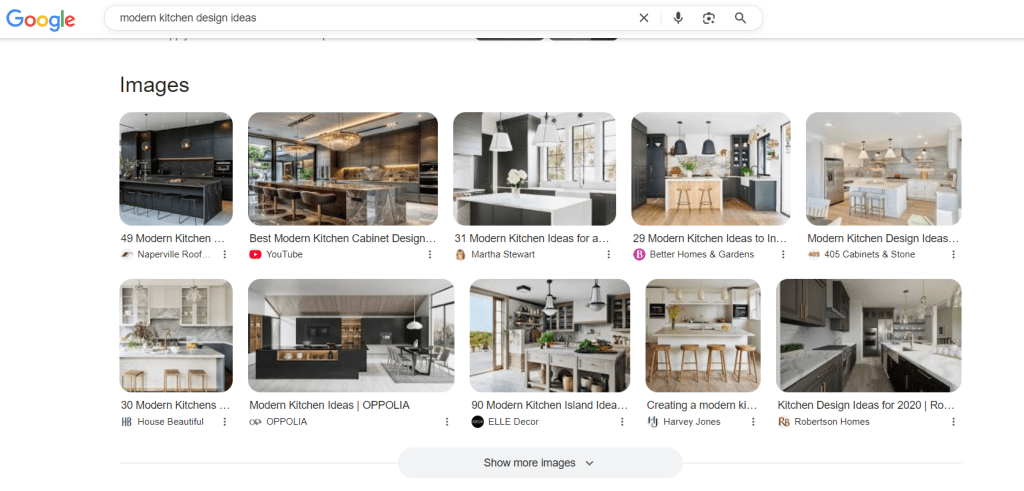
Image packs often appear alongside traditional organic results, creating additional visibility opportunities for websites with strong visual content. Users clicking on images are directed to Google Images, where they can then click through to the source website.
The key to image pack success lies in creating original, high-quality images that directly relate to your target keywords while providing clear value to users seeking visual information.
Video Carousels
Video carousels showcase relevant video content in horizontal, scrollable formats that appear prominently in search results. These features typically display 3-4 videos initially, with options to scroll for additional content.
YouTube dominates video carousels, but other platforms including social media sites and hosting platforms can also appear. The feature responds to queries with clear video intent, particularly tutorial, how-to, and entertainment-related searches.
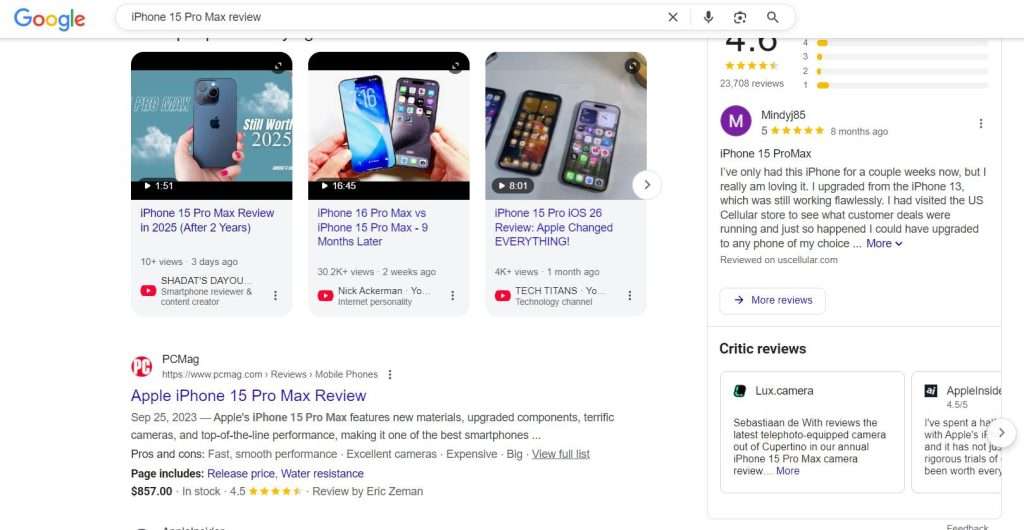
Video carousel optimization requires creating engaging, informative video content with descriptive titles, thumbnails, and descriptions that clearly communicate value to potential viewers.
The visual prominence of video carousels makes them difficult for users to ignore, creating significant traffic opportunities for businesses that invest in quality video content aligned with their target audience’s interests.
Rich Snippets
Rich snippets enhance traditional search listings with additional information extracted from structured data markup. These enhanced results can include star ratings, prices, availability, cooking times, and other relevant details that help users make informed decisions.
Implementation requires adding structured data markup to your website using schema.org vocabulary in JSON-LD format. Google’s Rich Results Test tool helps validate implementations and identify improvement opportunities.
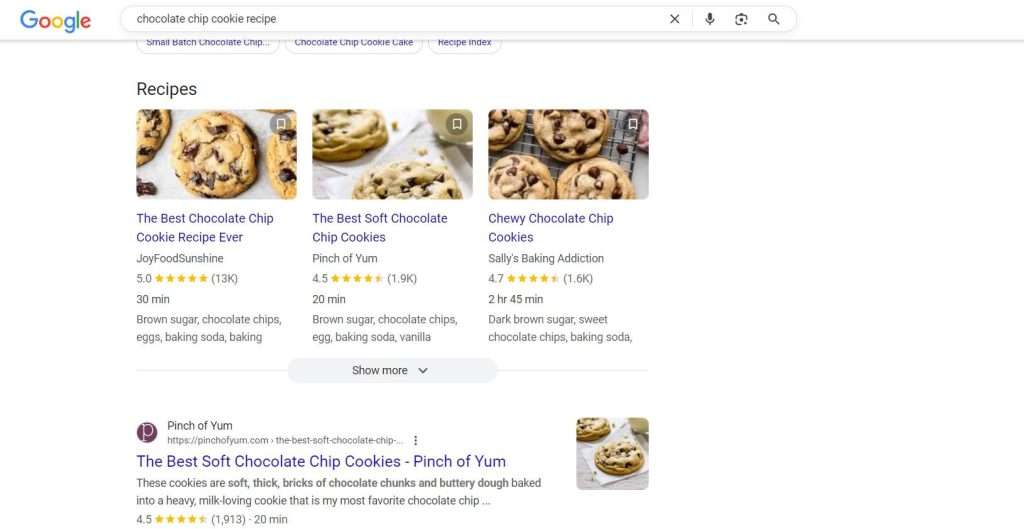
Rich snippets improve click-through rates by providing additional context that helps users determine result relevance before clicking. The enhanced listings stand out visually from standard organic results, creating competitive advantages.
Common rich snippet types include products, recipes, events, reviews, and FAQ content. Each type requires specific structured data implementation following Google’s guidelines for enhanced search appearance.
Discussions and Forums
The discussions and forums feature highlights relevant conversations from platforms like Reddit, Quora, and specialized forums directly in search results. This feature reflects users’ increasing trust in community-driven content and authentic user experiences.
These results appear with clear labeling as “Discussions and forums” and typically include question-and-answer formatted content that provides diverse perspectives on user queries.
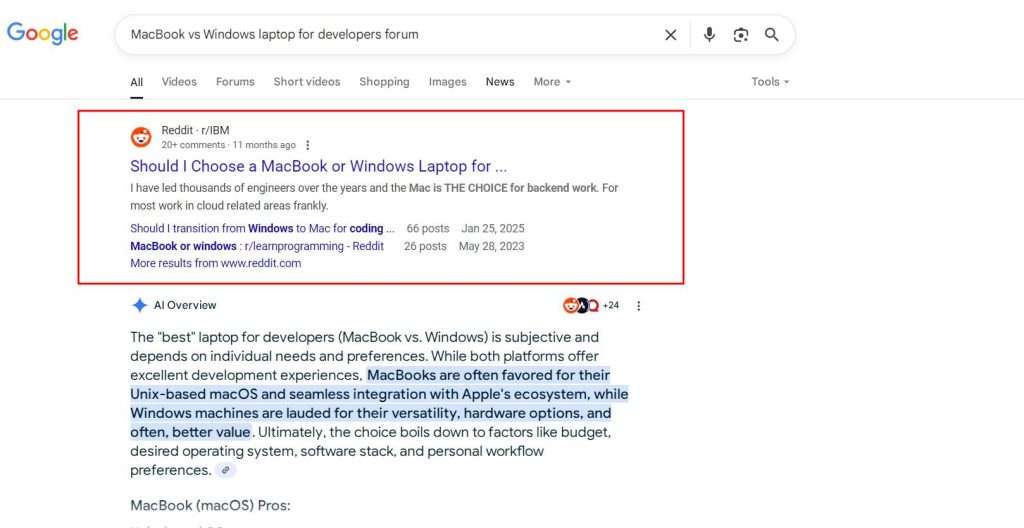
While you cannot directly optimize for this feature if you don’t own forum platforms, you can benefit by actively participating in relevant community discussions and providing helpful, authoritative answers that could be surfaced in search results.
The feature emphasizes the importance of community engagement and thought leadership in modern SEO strategies, rewarding businesses that actively contribute valuable insights to industry discussions.
Popular Products
Popular products features display relevant product listings for shopping-related queries, appearing in carousel formats with product images, prices, and ratings. These organic listings provide e-commerce opportunities without requiring paid advertising.
The feature typically appears for product-focused searches where users are researching or comparing specific items. Google pulls product information from various sources including merchant websites, review sites, and shopping platforms.
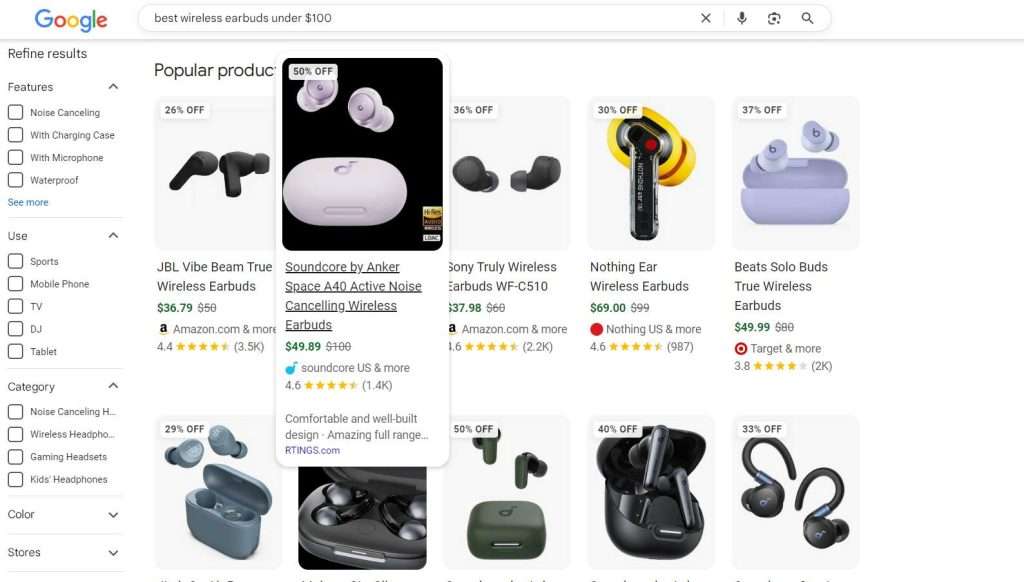
Optimization requires comprehensive product page optimization including high-quality images, detailed descriptions, competitive pricing, and positive customer reviews that can influence product selection and visibility.
E-commerce websites benefit most from this feature, but affiliate marketers and review sites can also capture traffic by creating comprehensive product comparison content.
Top Stories
Top stories carousels appear for news-related queries, displaying current articles from Google News-indexed sources. The feature prioritizes recency and relevance, making it valuable for publishers and news websites.
Articles appear in carousel format with headlines, publication dates, and source information. The feature helps users access current information about trending topics, breaking news, and recent developments.
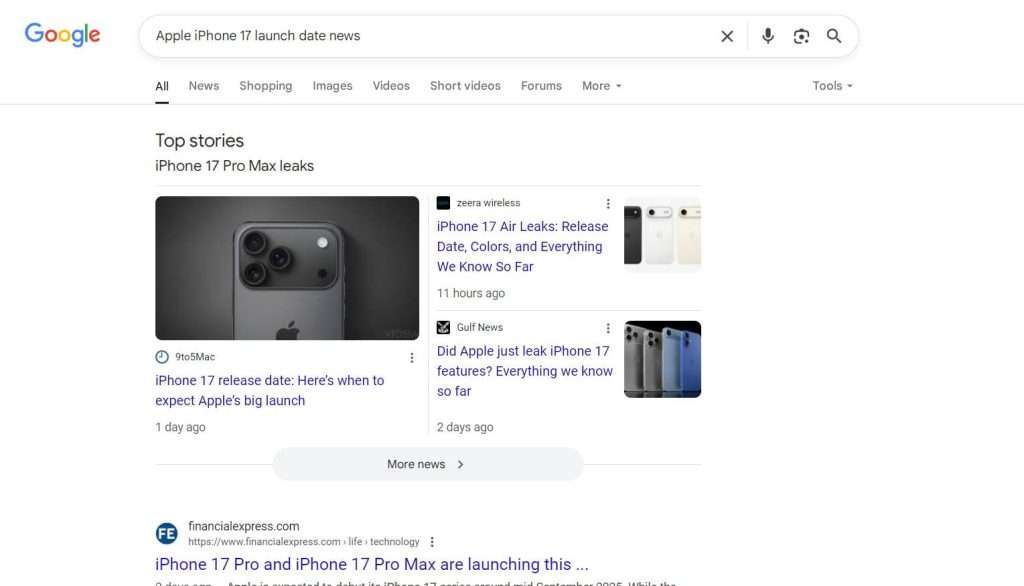
Optimization requires creating a dedicated news section with regular, original content that follows Google News guidelines. Publishers must apply for Google News inclusion and maintain consistent publication schedules.
The feature provides significant traffic opportunities for breaking news and trending topics, but requires consistent content creation and editorial resources to maintain visibility.
Other Notable SERP Features
Google continuously experiments with new serp features, creating emerging opportunities for early adopters. Recent additions include job listings for employment searches, events for local activities, and recipe cards for cooking-related queries.
Specialized features like hotel booking, flight information, and weather reports serve specific user intents while providing niche optimization opportunities for relevant businesses and content creators.
Staying current with emerging serp features requires monitoring Google’s official announcements, industry publications, and conducting regular SERP analysis for your target keywords to identify new opportunities as they develop.
How to Find SERP Features Opportunities
Identifying the right serp features to target requires systematic analysis of your keyword landscape, current rankings, and competitive environment. This strategic approach ensures you focus optimization efforts on features where you have realistic chances of success while maximizing potential traffic impact.
The challenge: Many SEO professionals waste time targeting serp features that are either too competitive or don’t align with their content strengths. Without proper opportunity identification, you might invest significant resources in optimization strategies that deliver minimal results.
The solution: A methodical approach combining keyword research, competitor analysis, and performance tracking helps you identify high-potential SERP feature opportunities that align with your content capabilities and business objectives.
Keyword Rank Tracker from Rush Analytics
The Rush Analytics Keyword Rank Tracker provides comprehensive SERP feature monitoring capabilities that streamline the opportunity identification process. This specialized tool tracks daily ranking changes across multiple search engines while monitoring which keywords trigger specific serp features.
The platform’s SERP feature tracking functionality helps you identify patterns in feature appearances, monitor competitor presence in various features, and track your optimization progress over time. The tool’s detailed reporting connects serp feature performance to actual traffic and conversion metrics.
Key capabilities include tracking featured snippets, People Also Ask boxes, local packs, and other prominent features across unlimited keywords. The tool provides historical data that reveals seasonal patterns and algorithm changes affecting feature appearances.
The competitive analysis features allow you to monitor up to 10 competitors simultaneously, identifying which serp features they’re capturing and revealing opportunity gaps in your market. This intelligence helps prioritize optimization efforts based on competitive landscape analysis.
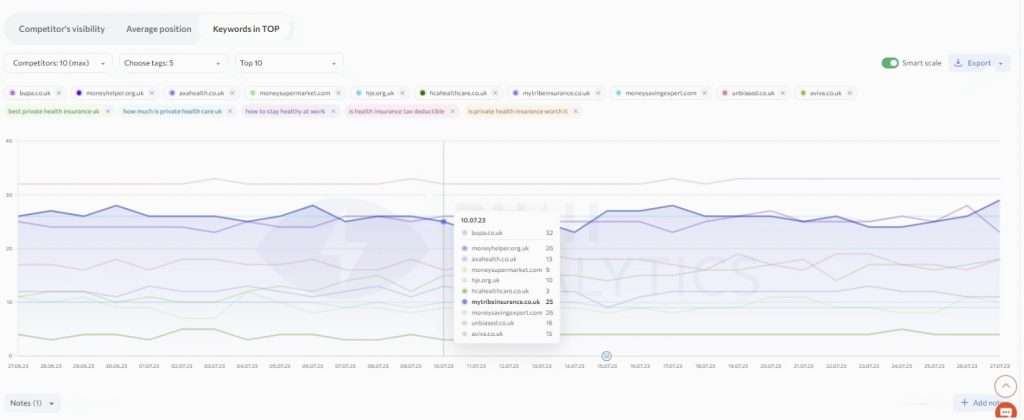
Integration with Google Search Console provides additional context by combining ranking data with actual traffic performance, helping you understand which serp features drive meaningful business results versus mere visibility improvements.
Manual Search Analysis
Manual search analysis provides direct insights into current serp feature landscapes for your target keywords. This hands-on approach helps you understand user intent, feature triggers, and competitive dynamics through direct observation.
Start by searching for your primary target keywords and documenting which serp features appear, their positions, and the types of content that successfully capture them. This baseline analysis reveals immediate opportunities and competitive threats.
Expand your analysis to include related keywords, long-tail variations, and question-based queries that might trigger different feature types. Use Google’s autocomplete suggestions and related searches to identify additional opportunity keywords.
Document patterns in feature appearances, noting which query types consistently trigger specific features. This pattern recognition helps you create targeted content strategies for different serp feature types.
Analyze Your Current Rankings
Your existing search performance provides valuable insights into potential serp feature opportunities. Pages already ranking in the top 10 organic results have higher probabilities of capturing serp features with proper optimization.
Use Google Search Console to identify your highest-performing pages and their primary keywords. Analyze these keywords to determine which serp features they trigger and whether your content could be optimized to capture them.
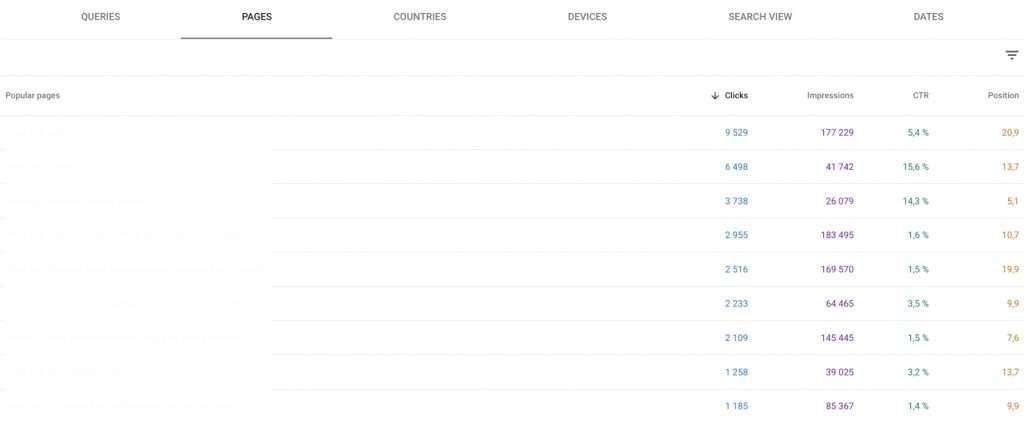
Focus on pages ranking in positions 1-10 for featured snippet opportunities, as these represent the most accessible targets for position zero capture. Look for patterns in queries that trigger multiple serp features simultaneously.
Consider the content formats of your top-performing pages. List-based content naturally aligns with featured snippets, while comprehensive guides might be better suited for AI Overview inclusion.
Using SEO Tools for SERP Analysis
Professional SEO tools provide scalable approaches to serp feature opportunity identification. Platforms like SEMrush, Ahrefs, and Moz offer dedicated SERP feature tracking that reveals competitive landscapes and opportunity gaps.
These tools provide historical data on feature appearances, helping you identify trending opportunities and seasonal patterns. Competitor analysis features reveal which serp features your competitors are capturing and suggest similar opportunities for your content.
Keyword research tools increasingly include serp feature data in their reports, allowing you to filter opportunities by feature type and competitive difficulty. This targeted approach helps prioritize optimization efforts based on realistic success probabilities.
Integration capabilities with other SEO tools and analytics platforms provide comprehensive performance tracking that connects serp feature visibility to broader business metrics.
Strategies to Optimize for Key SERP Features
Strategic SERP feature optimization requires targeted approaches aligning content structure and technical implementation with Google’s selection criteria. Each feature type demands specific optimization strategies for maximum success probability.
Strategic Optimization Framework: Understanding feature selection mechanisms enables optimization strategies that directly address criteria while maintaining content quality and user value.
Featured Snippet Optimization
Featured snippet optimization centers on delivering concise, accurate answers addressing user queries within the first 40-60 words. Structure content with question-based headings followed by immediate, definitive responses.
Strategic Implementation Process:
- Target Question Identification – Research queries triggering featured snippets in your niche
- Current Snippet Analysis – Study existing snippets for format preferences and content length
- Targeted Content Creation – Develop clear, direct answers with supporting details
- Format Optimization – Implement proper heading hierarchy and clear paragraph structure
- Performance Monitoring – Track results and adjust content based on performance data
Paragraph snippets require comprehensive definitions within 40-60 words followed by additional context. List snippets need numbered or bulleted formats with clear, actionable steps. Table snippets require properly formatted HTML tables with comparison data.
AI Overview Optimization
AI Overview optimization demands comprehensive, authoritative content covering topics thoroughly while maintaining accuracy and clear organization. Focus on developing in-depth resources providing complete answers to complex queries.
Structure content with clear headings directly addressing user questions. Use scannable formats with bullet points, numbered lists, and logical information hierarchy enabling easy AI system parsing.
Include supporting evidence, data, and examples demonstrating expertise and building trust. AI systems prefer content referencing authoritative sources while providing comprehensive topic coverage.
People Also Ask Optimization
People Also Ask optimization focuses on comprehensive FAQ sections addressing related questions around primary topics. Research common questions using tools like AnswerThePublic, Google autocomplete, and existing PAA boxes.
Structure answers to be concise yet complete, typically around 41 words for optimal PAA inclusion. Begin with direct answers followed by supporting details encouraging click-through to full content.
Create internal content clusters addressing multiple related questions, increasing chances for expanding PAA box appearances. Link related FAQ answers creating comprehensive information resources.
Local Pack Optimization
Local pack optimization requires comprehensive local SEO strategies centered on Google Business Profile optimization and local keyword targeting. Ensure NAP (Name, Address, Phone) consistency across all online directories.
Complete Google Business Profile with accurate information, high-quality photos, regular posts, and active review management. Encourage satisfied customers to leave positive reviews and respond professionally to all feedback.
Create location-specific content including local keywords, nearby landmarks, and community references. Develop separate pages for different service areas when serving multiple locations.
Knowledge Panel Optimization
Knowledge panel optimization requires building comprehensive entity authority through consistent information across multiple platforms. Create detailed About pages with complete business information, history, and key personnel details.
Establish Wikipedia presence when appropriate for entity size and notability. Maintain active, professional social media profiles with consistent branding and regular content updates.
Develop authoritative content establishing field expertise. Create comprehensive resource pages, publish industry insights, and build thought leadership through consistent content creation.
Rich Snippet Implementation
Rich snippet implementation requires adding structured data markup to web pages using schema.org vocabulary in JSON-LD format. Choose appropriate schema types based on content and business model.
Use Google’s Rich Results Test tool to validate implementations and identify improvement opportunities. Test markup regularly ensuring continued compatibility with Google’s requirements.
Common schema types include Product, Recipe, Event, Review, FAQ, and LocalBusiness. Each type requires specific properties and values matching visible page content accurately.
Measuring the Impact of SERP Features
Tracking SERP feature performance requires comprehensive measurement strategies that connect feature visibility to business outcomes. Understanding which features drive meaningful traffic and conversions helps prioritize optimization efforts and demonstrate ROI.
The measurement challenge: Traditional SEO metrics don’t fully capture SERP feature impact. You need specialized tracking approaches that reveal feature-specific performance while connecting visibility to business results.
The solution: Implement comprehensive tracking systems that monitor feature appearances, traffic sources, and conversion outcomes to build complete performance pictures.
Analytics and Tracking Tools
Google Analytics provides essential insights into SERP feature performance through traffic source analysis and user behavior tracking. Set up custom segments to isolate traffic from different feature types and analyze engagement patterns.
Google Search Console offers performance reports that show impressions, clicks, and average positions for pages appearing in various serp features. The Performance report helps identify which queries trigger features and drive traffic.
Specialized SEO tools like SEMrush, Ahrefs, and Moz provide dedicated SERP feature tracking capabilities. These platforms monitor feature appearances over time, track competitive presence, and provide historical data for trend analysis.
Custom tracking implementations using UTM parameters and event tracking can provide granular insights into feature performance. Tag different traffic sources to measure conversion rates and user value from various serp features.
Key Metrics to Monitor
Critical SERP feature metrics:
- Feature visibility frequency – How often your content appears in target features •
- Click-through rates – Percentage of feature impressions that generate clicks
- Traffic volume – Total visitors from different feature types
- Conversion rates – Percentage of feature traffic that completes desired actions
- Brand impression impact – Increased branded searches and direct traffic
Monitor position changes in traditional organic results alongside feature appearances. SERP features can influence overall ranking performance through improved user engagement signals.
Track competitive presence in target features to identify opportunity gaps and benchmark performance against industry standards. Regular competitive analysis reveals shifting landscapes and emerging opportunities.
Analyze user behavior patterns for feature-driven traffic compared to traditional organic visitors. Understanding engagement differences helps optimize content and conversion strategies for different traffic sources.
Conclusion
Mastering SERP features represents a fundamental shift in SEO strategy that goes beyond traditional ranking optimization. As search engines continue evolving toward more sophisticated, user-centric experiences, understanding how to find serp features opportunities becomes essential for maintaining competitive advantage.
The strategies outlined in this guide provide actionable frameworks for identifying, targeting, and winning valuable serp features that can transform your search visibility. From featured snippets to local packs, each feature type offers unique opportunities to connect with users at critical decision moments.
Success requires systematic implementation of feature-specific optimization strategies combined with comprehensive performance tracking. The most effective approach balances immediate tactical improvements with long-term strategic positioning as search continues evolving.
Remember that SERP feature optimization is an ongoing process requiring continuous monitoring, testing, and refinement. Algorithm changes, competitive dynamics, and user behavior shifts demand adaptable strategies that can evolve with the search landscape.
Start by implementing the opportunity identification strategies discussed in this guide. Focus on features that align with your content strengths and business objectives while building systematic approaches to performance measurement and optimization refinement.
FAQs
How to get SERP features?
Getting SERP features requires targeted content optimization that aligns with specific feature selection criteria. Create comprehensive, well-structured content that directly answers user queries while implementing appropriate technical elements like structured data markup. Focus on featured snippets by providing clear, concise answers within the first 40-60 words of your content, followed by supporting details.How to find SERP position?
Finding SERP positions requires using keyword tracking tools that monitor both traditional rankings and SERP feature appearances. Google Search Console provides basic position data, while specialized tools like SEMrush, Ahrefs, or Rush Analytics offer comprehensive tracking across multiple search engines and devices. Manual searches provide immediate insights but aren’t scalable for large keyword sets.How to do SERP analysis?
SERP analysis involves systematically examining search results for target keywords to identify feature opportunities, competitive landscapes, and optimization potential. Start by documenting which features appear for your target keywords, analyze competitor presence in various features, and identify content gaps where you could capture visibility. Use both manual observation and SEO tools to gather comprehensive data for strategic decision-making.






